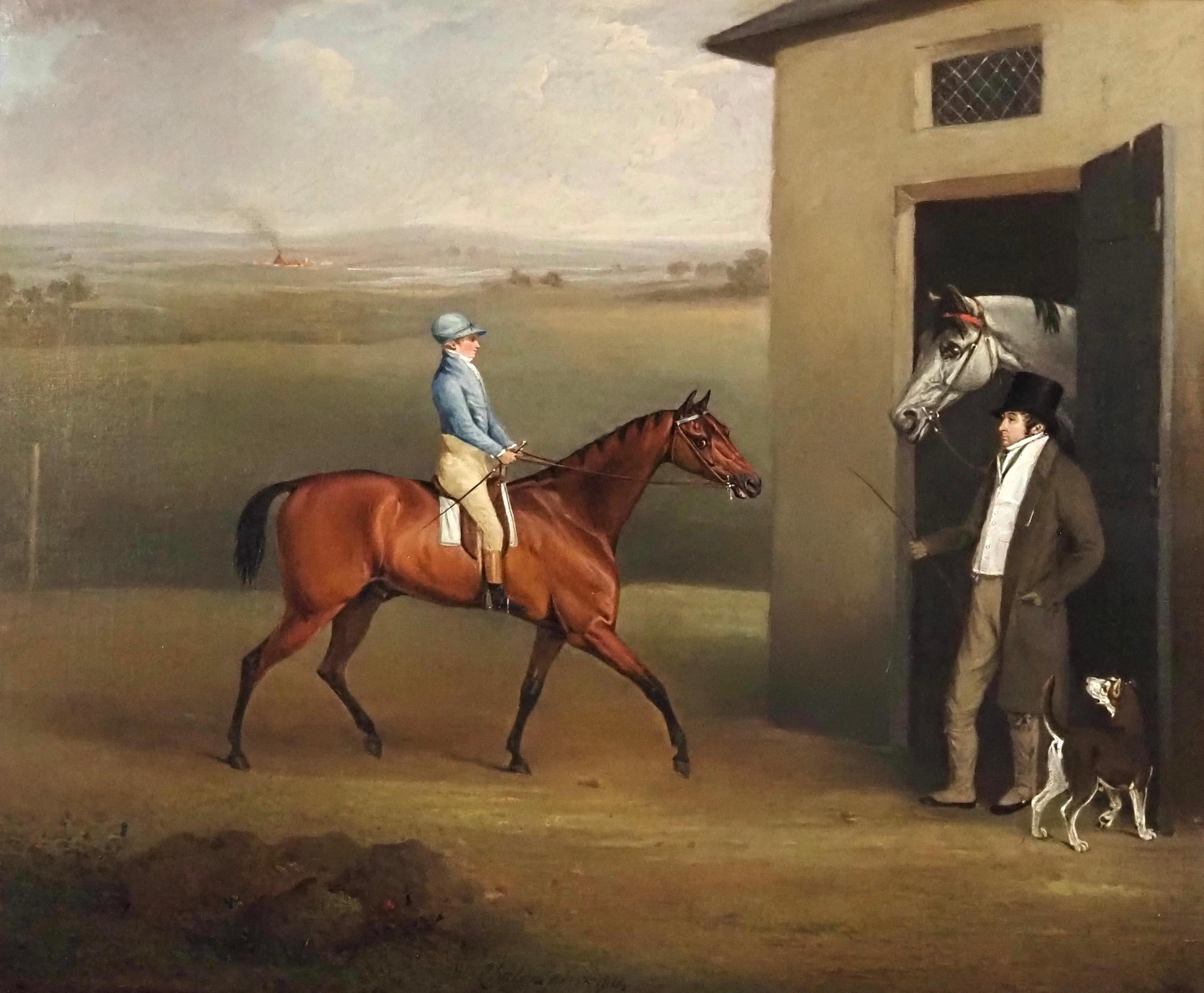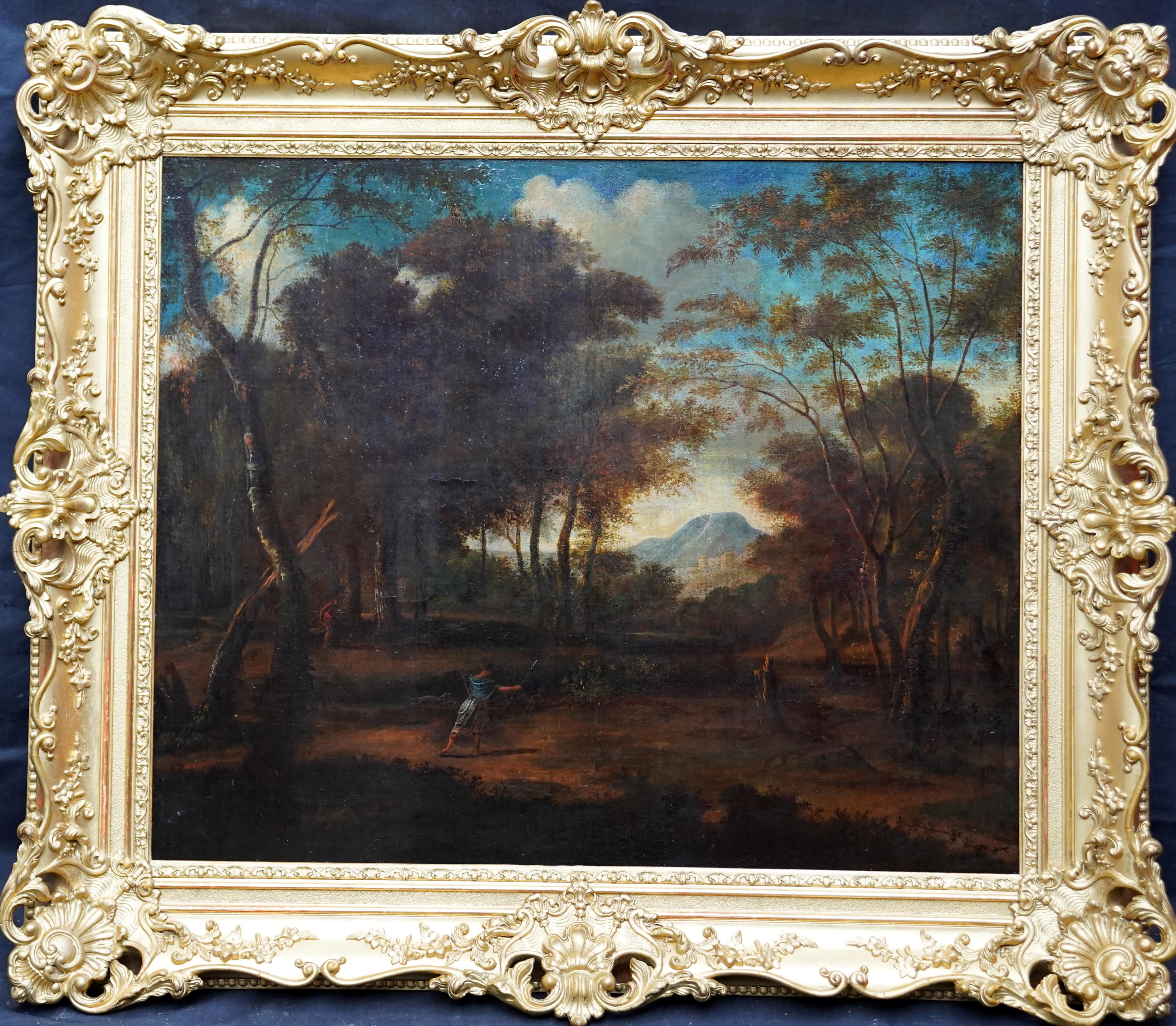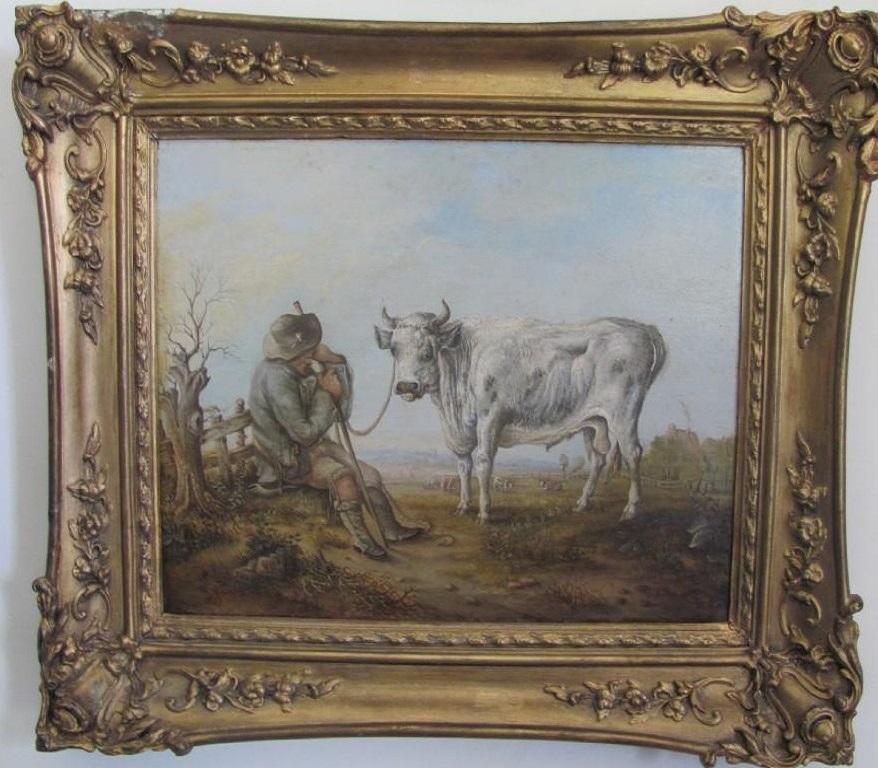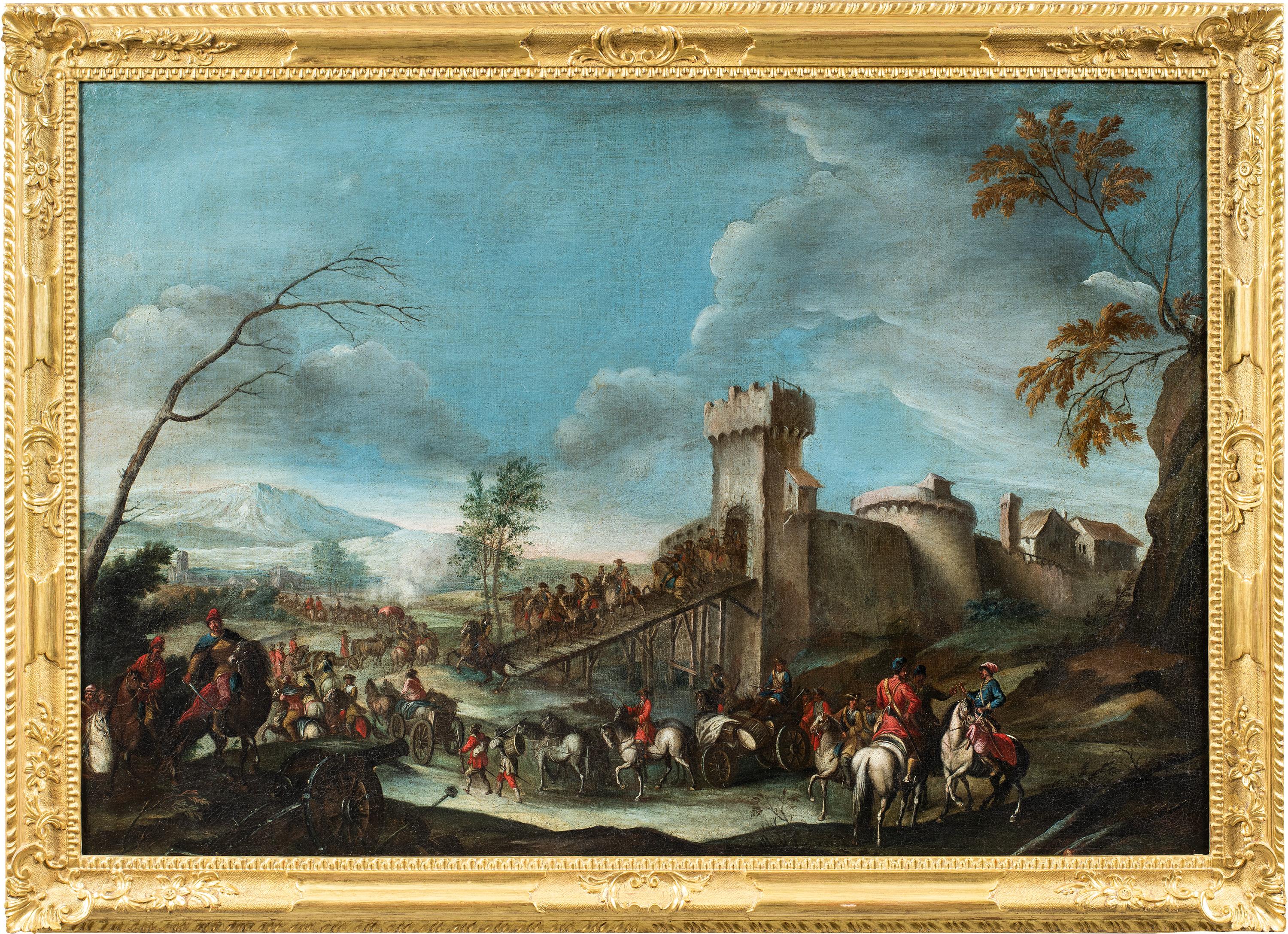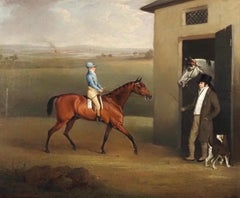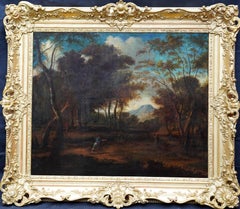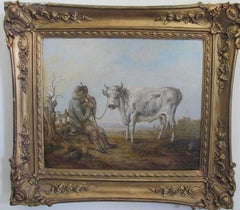Items Similar to Aeneas Dido Pseudo-caroselli 17Th Century Mythological Oil on canvas Old master
Want more images or videos?
Request additional images or videos from the seller
1 of 16
Aeneas Dido Pseudo-caroselli 17Th Century Mythological Oil on canvas Old master1630-1660
1630-1660
About the Item
Aeneas and Dido
Attributed to Pseudo-Caroselli (Rome, active c. 1630/1650)
Oil on canvas (148 × 93 cm. - framed 162 × 107 cm.)
(full details LINK)
The episode depicted in the superb canvas illustrates the beautiful Dido, queen of Carthage, in the moment of supplication towards her beloved Aeneas, who has now decided to abandon her.
According to the Virgilian narration in the 4th book of the Aeneid, Dido fell madly in love with the Trojan hero Aeneas, son of Anchises and Venus, when he landed in Carthage due to a storm caused by Juno before arriving in Latium. Everything seems to be heading for the most classic of happy endings, until Jupiter arrives implacably, and through Mercury, calls Aeneas back to duty, ordering him to leave again and reach Latium, where he will give rise to the race that will found the city of Rome.
Thanks to a highly theatrical staging with a clear Baroque imprint, we are confronted with an enthralling painting that illustrates a crucial moment in this passionate love story, which, after touching the heights of overwhelming passion, sees the drama of a woman in love follow.
Dido, famous for her beauty and sensuality, is here immortalised in the moment of pleading to her beloved, desperate for her imminent departure, although already aware of the fate that awaits her; she is intent on playing a lute in a last vain attempt to hold him back. Aeneas seems to be listening to the melody intoned in his honour, with a faltering expression, despite Mercury playing a transverse flute, as if to distract him from the queen's music.
His sadness is contrasted, however, by the diligence of the Trojans, whom we see feasting in the background, happy to resume their journey, as they evidently disapprove of the love between the two and the consequent prolongation of the pause.
The author thus seizes the pretext of the epic tale to depict a theme dear to seventeenth-century painting and extremely appreciated by collectors of this period, that dedicated to the universe of music;
The canvas that is the subject of this study, from which the strong suggestions to Caravaggism are immediately evident, can be attributed to the so-called 'Pseudo-Caroselli', a mysterious 'genre painter', perhaps of Nordic origin but whose identity is unknown, close to the manner of the master Angelo Caroselli (Rome 1585-1652), with whom he has often been confused.
He was certainly an artist who had frequented the workshop of the Roman master, most probably one of his pupils. The hypothesis that the Pseudo-Caroselli is a northern European artist, perhaps belonging to the populous colony of Flemish painters who stayed permanently in Rome in the 17th century, is quite widely accepted, but it cannot be ruled out (according to some authors) that it could be Angelo's son, Carlo Caroselli.
The painting clearly stands out as a milestone in the work of this mysterious author, both in terms of quality and the presence of full-length characters, demonstrating here his histrionic and theatrical skill and refined technique. Often the characters that appear in these paintings have grotesque poses and caricatured features, and there is usually a marked sensual allusion.
The painting is in good conservation condition with the presence of an old layer of varnish.
ADDITIONAL INFORMATION:
The painting is completed by a wooden frame and is sold with a certificate of authenticity and descriptive iconographic card.
We take care of and organise the transport of the purchased works, both for Italy and abroad, through professional and insured carriers.
Contact us for any information, we will be happy to answer you.
- Attributed to:Pseudo-caroselli (Rome, Active C. 1630/1650)
- Creation Year:1630-1660
- Dimensions:Height: 63.78 in (162 cm)Width: 42.13 in (107 cm)
- Medium:
- Movement & Style:
- Period:
- Condition:
- Gallery Location:Riva del Garda, IT
- Reference Number:1stDibs: LU988114899002
About the Seller
4.9
Platinum Seller
Premium sellers with a 4.7+ rating and 24-hour response times
Established in 2017
1stDibs seller since 2018
238 sales on 1stDibs
Typical response time: <1 hour
- ShippingRetrieving quote...Shipping from: Riva del Garda, Italy
- Return Policy
Authenticity Guarantee
In the unlikely event there’s an issue with an item’s authenticity, contact us within 1 year for a full refund. DetailsMoney-Back Guarantee
If your item is not as described, is damaged in transit, or does not arrive, contact us within 7 days for a full refund. Details24-Hour Cancellation
You have a 24-hour grace period in which to reconsider your purchase, with no questions asked.Vetted Professional Sellers
Our world-class sellers must adhere to strict standards for service and quality, maintaining the integrity of our listings.Price-Match Guarantee
If you find that a seller listed the same item for a lower price elsewhere, we’ll match it.Trusted Global Delivery
Our best-in-class carrier network provides specialized shipping options worldwide, including custom delivery.More From This Seller
View AllDiana Boullogne Mythological Paint Oil on canvas old master 17/18th Century
Located in Riva del Garda, IT
Bon Boullogne (Paris, 1649 - Paris, 1717) workshop of
Episodes from the myth of Diana
oil painting on canvas
Dimensions: 84 x 114 cm.
with antique frame 100 x 132 cm.
The beautiful painting proposed shows a series of episodes taken from the myth of the divinity Diana, the Roman divinity of hunting, forests and wild animals, masterfully captured in this valuable painting, which shows a luxuriant wood, a favorite place of the divinity, as a theater of his adventures.
The composition opens, on the left, with a sort of presentation of the divinity, portrayed as an attractive young girl, surrounded by her faithful Nymphs, one of whom holds her quiver with arrows, and by one of her beloved dogs. hunting her.
The 'story' continues in the central part where we can see the divinity during a wild boar hunt...
Category
Late 17th Century Old Masters Paintings
Materials
Oil
$8,160 Sale Price
20% Off
Landscape Marina See Van Der Velde Paint Oil on canvas Old master 17th Century
Located in Riva del Garda, IT
Quality work attributed to the painter Peter Van Der Velde (Antwerp 1634 - c.1714)
Coastal view with fortified city and boats (city of Antwerp?)
Oil pa...
Category
17th Century Old Masters Paintings
Materials
Oil
$14,400 Sale Price
20% Off
Christ Angels Pietro Da Cortona Paint Oil on canvas Old master 17th Century Art
Located in Riva del Garda, IT
Christ surrounded by angels in the desert
Circle of Pietro da Cortona, born as Pietro Berrettini (Cortona 1597 - Rome 1669)
Oils on canvas (66 x 50 cm. - in frame 80 x 64 cm.)
The ...
Category
17th Century Old Masters Paintings
Materials
Oil
$8,280 Sale Price
20% Off
Christ Samaritan Woman Pozzoserrato Paint Oil on table 17th Century Old master
Located in Riva del Garda, IT
Christ and the Samaritan woman at the well
Attributable to Ludovico Pozzoserrato (Antwerp circa 1550 - Treviso 1605)
Oil on the table
37 x 27 cm., In ...
Category
17th Century Old Masters Paintings
Materials
Oil
$5,280 Sale Price
20% Off
Annunciation Bonini Paint Oil in canvas Old master 17th Century Leonardo Italy
Located in Riva del Garda, IT
Girolamo Bonini, called Anconitano (Ancona, circa 1600 - Bologna 1680)
Annunciation (or Madonna of the Beautiful Angel)
Oil on canvas (115 x 91 cm. - Framed 134 x 108 cm.)
Work accompanied by the expertise of Prof. Emilio Negro
The work, undoubtedly commissioned as an object of private devotion, shows the Annunciation to the Virgin Mary, a Gospel episode here set on the two figures portrayed in the foreground, the Archangel Gabriel with outstretched wings, a portrait of supernatural beauty, and the Virgin;
We see her here absorbed in reading a prayer book with her eyes turned humbly downwards as a sign of devotion, while a small cherub hands her white lilies, a symbol of purity and chastity.
In the upper part of the composition is the austere image of God the Father, with the dove radiating with light, emblem of the Holy Spirit, surrounded by a flock of angels fluttering in the clouds charged with intense glow and play of light, in full Baroque style.
It should also be noted that the image of the Saviour's mother in a delicately pious attitude, with her yellow veil, her broad blue mantle and her usual modest red dress from which the edges of her white blouse protrude, is to be interpreted as a kind of tender allegory of sacred love.
The painting in question is an interesting replica with variants of the composition commissioned from Francesco Albani for the Fioravanti chapel in the ancient church...
Category
17th Century Old Masters Paintings
Materials
Oil
$14,400 Sale Price
20% Off
Madonna Scarsella Paint Oil on canvas Old master 16/17th Century Raffaello Art
Located in Riva del Garda, IT
Ippolito Scarsella, known as Lo Scarsellino (Ferrara, around 1550 - 1620) workshop
Altarpiece depicting the Madonna and Child, St. James the Greater and the donor in armour
Technique: oil on panel
Measurements: 93 x 72 cm./with frame 109 x 86 cm.
Provenance: Prato, Farsetti, auction of 28.10.2016, lot 261 (link)
A majestic Madonna in Glory occupies the upper register of the canvas, seated on a blanket of iridescent clouds surrounded by angels, flanked by a cherub who scatters flowers contained in a cornucopia towards the infant Christ as a sign of abundance, naked and supported with both hands from the mother.
In the lower part of the composition stands the figure of San Giacomo Maggiore, one of the twelve apostles, standing on the right side of the altarpiece, represented dressed in a humble tunic; one arm holds the open Gospel book, while the other holds a cross pilgrimage staff.
A particular aspect of the table is the presence in the central part, to indicate its importance, of the figure of the donor, kneeling on a cushion, with his hands joined in prayer and his face observing the Virgin in an attitude of devotion, while on the opposite lectern is placed a prayer book; depicted with the features of a young leader in armor, with a sword and a rich iridescent red cloak, elements which, combined with his authoritarian composure, enhance his ennoblement.
Unlike the medieval altarpieces, the knight is here included in the space of the painting and has proportionate dimensions to those of the other characters, returning to all intents and purposes in the sacred scene, with a pose that cannot but evoke the detail of the 'Montefeltro altarpiece' made by Piero della Francesca for Federico da Montefeltro, kneeling in front of the sacred group in the guise of a leader.
On the right, the view recedes into depth highlighting the background of an urban landscape set on a hill behind which a mountain range stands out, with the peculiarity of the arched aqueduct that runs along the entire landscape. Presumably among these expanses were the donor's own possessions and his hometown.
It is a quality table, imbued with the late Mannerist style still resistant in the second half of the 16th century, characterized by a 'sweet and affable religiosity, rendered through a manner of studied simplicity and grace', which highlights the unmistakable stylistic and chromatic connotations of the produced...
Category
16th Century Old Masters Paintings
Materials
Oil
$10,200 Sale Price
20% Off
You May Also Like
Tivoli Waterfall through Ponte Lupo - British Old Master landscape oil painting
Located in London, GB
This superb exhibited British 18th century Old Master Italian landscape oil painting is by noted artist Thomas Barker of Bath. Painted in 1794 and exhibited at the Royal Academy in 1...
Category
18th Century Old Masters Landscape Paintings
Materials
Oil
'Prime Minister' with jockey John Shepherd up, and owner Sir Mark Sykes
By Henry Bernard Chalon
Located in Stoke, Hampshire
Henry Bernard Chalon (London 1770-1849)
'Prime Minister' with jockey John Shepherd up, and owner Sir Mark Sykes
Signed and dated 'H.B. Chalon pinxit 181...
Category
Early 19th Century Old Masters Animal Paintings
Materials
Oil
Diana Hunting in Wooded Landscape - 17thC Old Master French art oil painting
By Jean François Millet
Located in London, GB
This superb French Old Master oil painting with excellent provenance is by Jean Francois I Millet. It was painted circa 1675 and is a figurative landscape depicting Diana hunting in ...
Category
17th Century Old Masters Landscape Paintings
Materials
Oil
19th Century Oil Farmer And Bull Country Landscape Scene After Aelbert Cuyp
By Aelbert Cuyp
Located in York, GB
After Aelbert Cuyp (unsigned) an oil on board country scene depicting a farmer and bull. The painting is in overall very good condition however the frame has some losses .Mainly to...
Category
19th Century Old Masters Landscape Paintings
Materials
Oil
Christian Reder (Italian master) - 18th centurylandscape painting - Soldiers
By Christian Reder (Monsù Leandro)
Located in Varmo, IT
Christian Reder (Leipzig 1656 - Rome 1729) - The departure of the soldiers from the fort.
57.5 x 108.5 cm without frame, 89 x 122 cm with frame.
Antique oil painting on canvas, in ...
Category
Early 18th Century Old Masters Landscape Paintings
Materials
Canvas, Oil
Moses and the Pillar of Cloud by Lucas Cranach the Elder and Studio
By Lucas Cranach the Elder
Located in New Orleans, LA
Lucas Cranach the Elder and Studio
1472-1553 German
Moses and the Pillar of Cloud
Oil on panel
Moses and the Pillar of Cloud is a bold and evocative composition that showcases the signature intense color and intricate detail of Lucas Cranach the Elder’s celebrated oeuvre. The remarkable 16th-century oil on panel by Lucas Cranach and his studio captures the narrative moment when Moses leads the Israelites out of Egypt and encounters God manifested through a large pillar of cloud. Moses stands at the precipice of a bridge and turns back to soldiers helping to lead the group of Israelites who huddle closely together. Cranach depicts Moses with his traditional iconography, rendering the rays of light on his head which came to be interpreted as "horns" in the translation of the Bible. Using his traditional walking staff, Moses gestures toward the pillar, seemingly acknowledging that God will protect the group as they cross the bridge to the other side, leaving exile and entering a promised land.
In a nod to Cranach’s Germanic locale, he renders the figures and setting in a manner that feels decisively more akin to European aesthetics than those of the Red Sea. Soldiers wear elaborate, gothic suits of armor that recall the livery of Northern European guardsmen. The terrain appears more like a European forest giving way to a sweeping valley than the arid landscape the Israelites trekked through on their journey across the Red Sea. Though still clearly recounting a story from the Old Testament, Cranach renders the cast of characters and setting in an earthly, familiar manner. This aesthetic shift speaks to Cranach’s own changing beliefs as he found himself at the center of the Protestant Reformation.
After first gaining recognition in 1505 as the official painter of Frederick the Wise, Cranach established a thriving painting and print studio in Wittenberg, Germany. Cranach was renowned for his court portraits and genre paintings and was also well known for his association with the famous protestant reformer Martin Luther, then under the protection of Frederick the Wise. As Wittenberg became a bastion of new religious thought, Cranach soon befriended Luther and played an active role in creating the printed materials that proliferated throughout the Reformation...
Category
16th Century Old Masters Figurative Paintings
Materials
Oil, Panel
Recently Viewed
View AllMore Ways To Browse
Old Hold
Old Master Roman
Classic Paintings Masters
Masters Of The Universe
Unknown Master Painting
Old Master Painting 17th Century
17th Century Old Master Oil Painting
Old Master Flemish
Italian Old Masters 17th Century
Old Master Painting Flemish
Oil Painting Mythological
Old Masters Attributed
Flute Painting
Grotesque Painting
Antique Paintings Mythological
Roman Baroque Painting
Seventeenth Century Paintings
Antique Music Book

